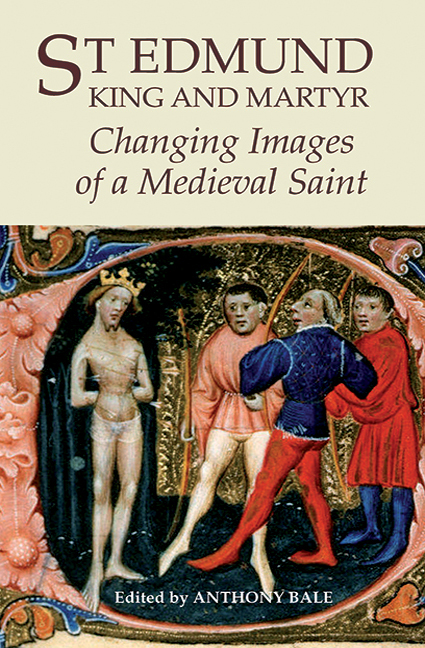Book contents
- Frontmatter
- Contents
- Preface
- List of Contributors
- List of Abbreviations
- Introduction: St Edmund's Medieval Lives
- 1 King, Martyr and Virgin: Imitatio Christi in Ælfric's Life of St Edmund
- 2 Chronology, Genealogy and Conversion: The Afterlife of St Edmund in the North
- 3 Geoffrey of Wells’ Liber de infantia sancti Edmundi and the ‘Anarchy’ of King Stephen's Reign
- 4 Music and Identity in Medieval Bury St Edmunds
- 5 Medieval images of St Edmund in Norfolk Churches
- 6 John Lydgate's Lives of Ss Edmund and Fremund: Politics, Hagiography and Literature
- 7 St Edmund in Fifteenth-Century London: The Lydgatian Miracles of St Edmund
- 8 The Later Lives of St Edmund: John Lydgate to John Stow
- Select Bibliography
- Index
- Miscellaneous Endmatter
6 - John Lydgate's Lives of Ss Edmund and Fremund: Politics, Hagiography and Literature
Published online by Cambridge University Press: 11 May 2017
- Frontmatter
- Contents
- Preface
- List of Contributors
- List of Abbreviations
- Introduction: St Edmund's Medieval Lives
- 1 King, Martyr and Virgin: Imitatio Christi in Ælfric's Life of St Edmund
- 2 Chronology, Genealogy and Conversion: The Afterlife of St Edmund in the North
- 3 Geoffrey of Wells’ Liber de infantia sancti Edmundi and the ‘Anarchy’ of King Stephen's Reign
- 4 Music and Identity in Medieval Bury St Edmunds
- 5 Medieval images of St Edmund in Norfolk Churches
- 6 John Lydgate's Lives of Ss Edmund and Fremund: Politics, Hagiography and Literature
- 7 St Edmund in Fifteenth-Century London: The Lydgatian Miracles of St Edmund
- 8 The Later Lives of St Edmund: John Lydgate to John Stow
- Select Bibliography
- Index
- Miscellaneous Endmatter
Summary
John Lydgate's Lives of Ss Edmund and Fremund seems to have been conceived as an immediate response to the visit of the young Henry VI to the Benedictine Abbey of Bury St Edmunds, where he was resident from Christmas Eve 1433 until 23 April 1434, when he was admitted to the abbey's confraternity. Lydgate (c. 1370–1449) was himself a monk in the abbey, which he had entered in his youth and to which he had returned in the early 1430s after various forms of clerical and political service in the outside world. His time in the public sphere was chiefly a consequence of his established status as the most prolific and versatile English poet of the fifteenth century. His return to the abbey did nothing to lessen his poetic output. Indeed, his presence made him the inevitable choice for the execution of such an important commission as the commemoration of Henry's extended stay in the abbey. As Lydgate explains in his poem, this commission was the idea of his abbot, William Curteys:
… to the kyng for to do pleasaunce
Thabbot William, his humble chapeleyn
Gaf me in charge to do myn attendance
The noble story to translate in substaunce
…
He in ful purpos to yeue it to the kyng (lines 107–10, 112)
Curteys was an adroit statesman who came to enjoy Henry VI's favour and steadfastly pursued the abbey's larger political and economic interests. Lydgate's poem was evidently conceived by his abbot as a means of confirming the abbey's relationship with the king by reminding him of the generosity that it had shown him. His memorial of the king's visit was an elaborate one in which poetic content and material form were carefully integrated. After Lydgate had completed his work, a de luxe presentation copy was prepared for presentation to Henry VI, probably in the late 1430s, presumably at the initiative of the abbot. This manuscript is now BL, Harley MS 2278, and it is among the most sumptuous of surviving fifteenth-century English manuscripts, containing a hundred and twenty miniatures, nearly all of which illustrate aspects of the narrative and reflect an unusually detailed awareness of Lydgate's text. The text itself, composed primarily in rhyme royal, with ballade stanzas at the beginning and end, is the most developed literary examination of the legend of St Edmund: the full text amounts to just over 3,600 lines.
- Type
- Chapter
- Information
- St Edmund, King and MartyrChanging Images of a Medieval Saint, pp. 133 - 144Publisher: Boydell & BrewerPrint publication year: 2009



